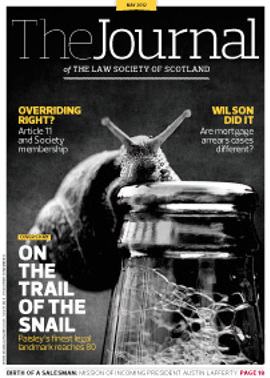Wind farms: a challenge to registration

Wind power is Scotland’s fastest-growing renewable energy technology. The Scottish Government has a target to meet an equivalent of 100% demand for electricity from renewable energy by 2020. The majority of this is likely to come from wind power, generated by, in the main, on-shore wind farms. Presently, there are almost 120 wind farm sites in operation, with many more either in construction or at various stages of the planning process. This continuing growth in wind farms presents a number of specific land registration challenges for both the conveyancer and the Keeper.
Wind farms come in a range of sizes, from the small community turbine to large-scale wind farm sites with many turbines. Preparatory work is, for instance, currently underway for a number of proposed wind farm sites in Shetland, which in total will extend to over 170 square kilometres. It is this scale of wind-farm development that presents the two key challenges: identifying all the existing interests in the area of the wind farm and preparing the deed plan for the site.
Identifying title
With large-scale wind farms, it is essential that all appropriate interests are identified. That can be challenging, particularly so in the more northerly rural areas where, in addition to identifying the many landowners and other parties with existing leasehold rights, there is also the need to identify those many individuals who may have crofting rights.
Property and leasehold titles in the more northerly rural areas are likely to be on the Sasine Register as rural areas have less land registration coverage. For Scotland as a whole, land mass coverage stands at 21% but, for instance, in Sutherland it is only 15% and in the Northern Isles it is a mere 8%. Traditionally, the more aged rural titles tend to contain general descriptions unsupported by deed plans. Dealing with a myriad range of such titles is a challenge.
John King explains: “Registers of Scotland can provide support to the conveyancer through our Title Investigation Service. We have carried out a number of wind farm investigations using our access to old and new maps and the latest mapping technologies to assist in identifying ownership and leasehold interests in the wind farm area.”
Jennifer Ballantyne confirms, “We have used RoS’ services to map the various Sasine titles which together make up the access route to one of our clients’ wind farm sites and, in another case, the combination of registered and Sasine titles which comprise the wind farm site itself. The process was essential to satisfying the banks who were lending to the projects in question that they would receive good security and no surprises would emerge during the registration process.
“RoS was very prompt in dealing with such enquiries and we worked with our clients’ technical advisers and the RoS mapping team to ensure the digital data ultimately submitted to the Keeper in support of the relevant applications for registration was accurate, consistent with the underlying titles, and in the correct format for RoS’ purposes.”
Preparing the wind farm lease
John King continues: “Our experience indicates that wind farms tend to be the subject of a long lease. The lease itself can take a number of forms; some will encompass the whole area of ground on which all of the wind turbines will be erected, whereas others cover each of the turbine footprints with various access and utility rights over the unleased areas between the turbines. Our recommendation is that where possible a lease of the whole wind farm site is preferable.
“This can avoid issues that will inevitably arise as to the identification and plotting of the turbine footprints. Leases of the individual footprints will have to be sufficiently detailed to enable their accurate plotting on to the Ordnance map – that can be problematic in remote areas where there is a lack of physical features to aid positioning.
“It is almost impossible to represent the footprint accurately unless mapping co-ordinates are provided and supported by a digital plan. Even then, with ground conditions and micrositing, the conveyancer runs the risk that the turbines will not be physically located in the exact spot of the legal footprint – a fact that will be picked up when the Ordnance Survey captures the built detail.”
Graham Little, Head of Production at Ordnance Survey explains: “Ordnance Survey undertakes as-built surveys of wind farm developments, using digital aerial photography or satellite positioning. To ensure that the design position and the as-built position are coincident, it is critical that the ‘setting out’ process faithfully replicates the design location on the ground.
“This ‘setting out’ can best be achieved using high-order satellite positioning. Such practice will ensure that the intended footprint and the as-built survey are coincident and therefore facilitate title registration. A lease of the site also avoids the need to narrate and detail the access and utility rights between each turbine footprint.”
Regardless of the approach taken, the lease will need to be supported by a plan that enables the Keeper to identify the subjects on the Ordnance map. The paper deed plan must be of no less a scale than the underlying Ordnance map-base scale (likely to be 1:10,000 in upland areas). RoS has, in the past, received plans based on the 1:50,000 Ordnance Survey raster map, reflecting the fact that the area for which registration is sought is extensive. Whilst RoS has sought to work with these plans in the past, it will not do so in the future because of the lack of detail.
Even if RoS could reconcile the external boundaries, basing a title plan on such a deed plan is unlikely to provide the quality of information that a conveyancer and their client require. So it is unlikely RoS will be able to identify all the rights, burdens and restrictions affecting both the wind farm and the surrounding area on the title plan. However, RoS can supplement the title plan information with a supplementary plan though the preference is, where practicable, to detail the information on the title plan.
Digital data
John King continues: “Our preference is for any paper deed plan to be supported by a digital plan. The advantage of submitting the digital data is that the process of transferring this data onto the mapping system used by RoS is a simple and straightforward one. The information can quickly be reconciled with the OS Map, allowing for a considerably reduced resource process. It also means that most, if not all, references can be clearly shown on the title plan.”
Jennifer Ballantyne explains further: “Knowing that RoS can make use of digital data is extremely helpful to legal professionals and their clients. As solicitors, we want the outcome of the registration process to include an accurate and helpful title plan reflecting the detail that is important to our clients. The most effective way of realising this is to provide RoS with the existing digital data for the wind farm.”
The key to the successful registration of a wind farm lease is for the solicitor to work in tandem with RoS. Solicitors are encouraged to contact RoS in advance of any potential wind farm registration to talk through the mapping and title issues.
Further information: pre-registrationenquiries@ros.gov.uk or RoS Title Investigation Team: fiona.martin@ros.gov.uk www.scotland.gov.uk
In this issue
- Arguments in store
- Farming the constitution
- Willing to wound, yet afraid to strike?
- Deferred consideration – worth the paper?
- OSCR: the secondees' perspective
- To efficiency and beyond
- Reading for pleasure
- Opinion column: Fraser Tait
- Council profile
- Book reviews
- President's column
- Wind farms: a challenge to registration
- Snail of the century
- Rights both ways
- Sell, sell, sell
- RBS v Wilson: light in the tunnel?
- Take the heat out
- Prepare for case management
- Looking into the past
- Migrant days numbered
- CPI - the story so far
- Brighton declares
- Mary Mary quite contrary?
- How to avoid that Guarantee Fund interview, and worse...
- Law reform roundup
- Apportionment of price for SDLT
- Business checklist
- Practical guide to legal risks
- Ask Ash






